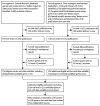Genetic variants associated with breast-cancer risk: comprehensive research synopsis, meta-analysis, and epidemiological evidence
- PMID: 21514219
- PMCID: PMC3114278
- DOI: 10.1016/S1470-2045(11)70076-6
Genetic variants associated with breast-cancer risk: comprehensive research synopsis, meta-analysis, and epidemiological evidence
Abstract
Background: More than 1000 reports have been published in the past two decades on associations between variants in candidate genes and risk of breast cancer. Results have been generally inconsistent. We did a literature search and meta-analyses to provide a synopsis of the current understanding of the genetic architecture of breast-cancer risk.
Methods: A systematic literature search for candidate-gene association studies of breast-cancer risk was done in two stages, using PubMed on or before Feb 28, 2010. A total of 24,500 publications were identified, of which 1059 were deemed eligible for inclusion. Meta-analyses were done for 279 genetic variants in 128 candidate genes or chromosomal loci that had at least three data sources. Variants with significant associations by meta-analysis were assessed using the Venice criteria and scored as having strong, moderate, or weak cumulative evidence for an association with breast-cancer risk.
Findings: 51 variants in 40 genes showed significant associations with breast-cancer risk. Cumulative epidemiological evidence of an association was graded as strong for ten variants in six genes (ATM, CASP8, CHEK2, CTLA4, NBN, and TP53), moderate for four variants in four genes (ATM, CYP19A1, TERT, and XRCC3), and weak for 37 variants. Additionally, in meta-analyses that included a minimum of 10,000 cases and 10,000 controls, convincing evidence of no association with breast-cancer risk was identified for 45 variants in 37 genes.
Interpretation: Whereas most genetic variants assessed in previous candidate-gene studies showed no association with breast-cancer risk in meta-analyses, 14 variants in nine genes had moderate to strong evidence for an association. Further evaluation of these variants is warranted.
Funding: US National Cancer Institute.
Copyright © 2011 Elsevier Ltd. All rights reserved.
Conflict of interest statement
The authors declared no conflicts of interest.
Comment in
-
Genetic variants associated with breast-cancer risk.Lancet Oncol. 2011 May;12(5):415-6. doi: 10.1016/S1470-2045(11)70084-5. Epub 2011 Apr 20. Lancet Oncol. 2011. PMID: 21514220 No abstract available.
References
-
- Lichtenstein P, Holm NV, Verkasalo PK, et al. Environmental and heritable factors in the causation of cancer--analyses of cohorts of twins from Sweden, Denmark, and Finland. N Engl J Med. 2000;343(2):78–85. - PubMed
-
- Stratton MR, Rahman N. The emerging landscape of breast cancer susceptibility. Nat Genet. 2008;40(1):17–22. - PubMed
-
- Stacey SN, Manolescu A, Sulem P, et al. Common variants on chromosomes 2q35 and 16q12 confer susceptibility to estrogen receptor-positive breast cancer. Nat Genet. 2007;39(7):865–9. - PubMed
Publication types
MeSH terms
Substances
Grants and funding
LinkOut - more resources
Full Text Sources
Medical
Research Materials
Miscellaneous


